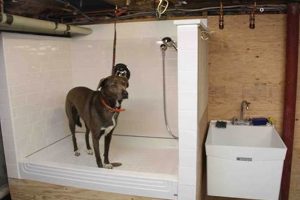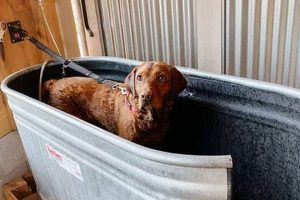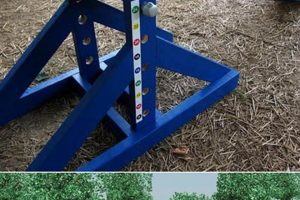Constructions of custom resting places intended for substantial canine breeds represent a segment of the broader practice of creating personalized pet accommodations. These bespoke solutions often involve utilizing readily available materials and basic construction techniques to fabricate beds specifically tailored to the size and weight of larger dogs, differing from commercially produced options in their adaptability and cost-effectiveness.
Providing a supportive and appropriately sized sleeping area for larger canines contributes significantly to their overall well-being. Benefits include improved joint health, enhanced comfort, and a reduction in pressure points. Historically, the creation of custom animal bedding has reflected both resourcefulness and a desire to cater to the specific needs of individual animals, predating the widespread availability of standardized pet products.
The subsequent sections will detail various approaches to fabricating these custom canine resting spaces, examining material selection, structural considerations, and practical construction methodologies appropriate for larger breeds.
Construction Considerations for Substantial Canine Beds
The following guidelines offer practical advice for building custom sleeping spaces designed for large dogs, emphasizing durability and comfort.
Tip 1: Material Selection: Prioritize durable fabrics such as canvas, denim, or outdoor-rated materials to withstand wear and tear from larger dogs. Consider water-resistant options to protect the bed’s interior from accidents or spills.
Tip 2: Frame Construction: If incorporating a frame, utilize sturdy wood or metal to ensure structural integrity. Reinforce joints with screws, bolts, or metal brackets to prevent collapse under the dog’s weight.
Tip 3: Filling Considerations: Employ high-density foam or shredded memory foam for optimal support. Avoid lightweight fillings that may compress quickly, reducing comfort and requiring frequent replacement.
Tip 4: Size Determination: Accurately measure the dog’s length and width while sleeping to determine the appropriate bed dimensions. Add a minimum of 6-12 inches to these measurements to allow for comfortable stretching and movement.
Tip 5: Reinforcement of Seams: When sewing fabric components, reinforce seams with multiple rows of stitching and use heavy-duty thread. This minimizes the risk of tearing or unraveling, extending the bed’s lifespan.
Tip 6: Accessibility Considerations: For older or arthritic dogs, design a low-profile bed or incorporate a ramp for easy access. This minimizes strain on joints during entry and exit.
Tip 7: Cleaning and Maintenance: Design the bed with removable and washable covers to facilitate regular cleaning and hygiene. Consider using zippers or Velcro closures for easy removal and replacement.
Implementing these tips can result in the creation of a robust and comfortable resting place, specifically designed to meet the needs of a large dog. Attention to material selection, structural integrity, and accessibility will contribute to the bed’s longevity and the dog’s well-being.
The subsequent section will provide specific project examples, outlining different construction techniques applicable to diverse skill levels.
1. Durability
Durability, in the context of custom-built resting spaces for substantial canine breeds, represents the capacity of the structure to withstand prolonged use and resist degradation from the animal’s weight, movement, and potential destructive behaviors. Its importance stems from the significant investment of time and resources required for construction, as well as the need to provide a safe and consistently comfortable environment for the dog.
- Material Resistance to Tearing and Abrasion
The selection of robust fabrics, such as heavy-duty canvas or tightly woven denim, is paramount. These materials exhibit enhanced resistance to tearing, abrasion, and puncture, mitigating damage from scratching, digging, and general wear. Commercial examples include the use of ballistic nylon in high-wear areas, offering exceptional durability. The implication is a longer lifespan for the bed and a reduced need for frequent repairs or replacements.
- Structural Integrity of the Frame
For beds incorporating a frame, whether constructed from wood or metal, the strength and stability of the structure are crucial. Wood frames should utilize hardwoods or pressure-treated lumber, while metal frames should employ welded joints and sufficient gauge steel. Real-world examples include the use of mortise-and-tenon joinery in wooden frames to enhance strength. The implication is that the bed can support the dog’s weight without collapsing or becoming unstable, ensuring safety and comfort.
- Seam Reinforcement and Stitch Quality
The seams that hold the fabric components together represent a critical point of potential failure. Reinforcing these seams with multiple rows of stitching, utilizing heavy-duty thread, and employing techniques such as serging or binding increases their resistance to tearing and unraveling. Examples include the use of a double-needle lockstitch machine for enhanced seam strength. The implication is that the bed will remain intact even under significant stress, preventing the filling from escaping and maintaining its structural integrity.
- Resistance to Environmental Factors
Depending on the bed’s intended location, resistance to environmental factors such as moisture, sunlight, and temperature fluctuations may be important. Water-resistant or waterproof fabrics can prevent moisture damage, while UV-resistant materials can mitigate fading and degradation from sunlight exposure. Examples include the use of outdoor-rated fabrics treated with water-repellent coatings. The implication is that the bed can withstand exposure to the elements without deteriorating, making it suitable for both indoor and outdoor use.
In conclusion, durability in custom-built dog beds for large breeds is a multifaceted consideration encompassing material selection, structural design, and environmental resistance. By prioritizing these factors, builders can create resting spaces that offer long-lasting comfort, safety, and value, minimizing the need for frequent repairs or replacements and ensuring the dog’s continued well-being.
2. Support
In the realm of custom resting places for substantial canine breeds, the concept of support transcends mere cushioning; it encompasses the structural and material characteristics that contribute to the animal’s musculoskeletal well-being. Adequate support is not a luxury but a necessity, mitigating potential health complications associated with inadequate or inappropriate bedding.
- Density and Compression Resistance of Filling Materials
The selected filling material’s density and its resistance to compression under sustained weight are paramount. High-density foam or shredded memory foam offer superior support compared to less dense alternatives like fiberfill. A practical illustration is the comparison between a bed filled with low-density polyester fiber, which quickly flattens under a large dog’s weight, and one filled with high-density memory foam that maintains its shape and provides consistent support. The implication is a reduction in pressure points, minimizing the risk of joint pain and discomfort.
- Conformity to Body Contours
Effective support necessitates conformity to the animal’s body contours, distributing weight evenly and preventing localized pressure. Memory foam, in particular, excels at this, molding to the dog’s shape and providing customized support. This is exemplified by observing how memory foam beds alleviate pressure on bony prominences such as hips and elbows, in contrast to traditional beds that may create pressure points. The resultant benefit is improved circulation and reduced risk of pressure sores, particularly beneficial for older or less mobile dogs.
- Edge Support and Structural Stability
The perimeter of the bed must offer sufficient support to prevent sagging or collapse when the dog rests against it. This is often achieved through reinforced edges or the incorporation of a supportive frame. A real-world example is a bed with bolstered sides filled with dense foam, providing a secure and supportive perimeter for the dog to lean against. The implication is enhanced comfort and a sense of security, preventing the dog from feeling like it is rolling off the bed.
- Orthopedic Considerations
For dogs with pre-existing orthopedic conditions such as arthritis or hip dysplasia, specialized orthopedic beds are often necessary. These beds typically utilize multiple layers of high-density foam, including a layer of memory foam for pressure relief and a firmer support layer to maintain spinal alignment. An illustration is the use of egg-crate foam in conjunction with memory foam to promote air circulation and further reduce pressure points. The implication is a significant improvement in comfort and pain management for dogs with musculoskeletal issues, potentially slowing the progression of their conditions.
The multifaceted nature of support within the context of custom-built canine resting spaces highlights its critical role in ensuring the animal’s long-term health and well-being. The careful selection of appropriate materials and the implementation of sound construction techniques directly translate to improved comfort, reduced risk of musculoskeletal issues, and an enhanced quality of life for the large dog.
3. Size
Size, in the context of self-constructed canine beds tailored for larger breeds, is not merely a dimensional attribute but a critical determinant of the bed’s functionality and the animal’s well-being. The direct effect of an improperly sized bed manifests as discomfort, inadequate support, and potential behavioral issues, such as reluctance to use the bed. Conversely, a properly sized bed provides ample space for the dog to stretch out, relax, and achieve restful sleep, contributing to improved physical and mental health. For instance, a Great Dane requires significantly more surface area than a Labrador Retriever; failing to account for this disparity renders the bed inadequate. The importance of accurate sizing is paramount, transforming the bed from a mere resting place into a sanctuary that promotes comfort and security.
Practical application of this understanding involves precise measurement of the dog’s sleeping posture. Determining the maximum length and width the animal occupies when fully extended is essential. Adding a buffer of several inches to these measurements ensures that the dog is not constrained by the bed’s edges. Consideration should also be given to the bed’s height, particularly for older or arthritic dogs. A low-profile bed, or one incorporating a ramp, facilitates easy access and minimizes strain on joints. Specific examples include orthopedic beds designed with elevated sides to provide head and neck support, requiring adjustments to overall dimensions to accommodate the bolstered design. The material choices must also be influenced by size; larger beds necessitate sturdier fabrics and more substantial filling materials to maintain structural integrity and provide adequate support across the entire surface area.
In summary, the size of a self-made canine bed for a large breed is inextricably linked to its effectiveness in providing comfort, support, and security. Challenges arise in accurately measuring the dog’s sleeping posture and translating these measurements into appropriate bed dimensions. Furthermore, ensuring that material choices and construction techniques are commensurate with the bed’s size is crucial. Ignoring these factors diminishes the bed’s value and potentially compromises the animal’s well-being, underscoring the importance of meticulous planning and execution.
4. Materials
Material selection represents a foundational aspect of constructing canine beds specifically designed for large breeds. The longevity, comfort, and safety of the bed are intrinsically linked to the chosen materials, necessitating careful consideration of their properties and suitability.
- Fabric Durability and Resistance
The outer fabric layer directly impacts the bed’s ability to withstand wear and tear from a large dog’s weight, movement, and potential scratching or chewing. Durable fabrics such as heavy-duty canvas, denim, or tightly woven upholstery fabrics are preferred. Real-world examples include the use of ripstop nylon in areas prone to damage and the application of water-resistant coatings to protect against spills and accidents. The implications of selecting an inadequate fabric include premature wear, tearing, and potential ingestion of fabric fragments by the dog.
- Filling Material Support and Comfort
The filling material provides cushioning and support, influencing the dog’s comfort and joint health. High-density foam, memory foam, and shredded latex offer superior support compared to less expensive alternatives like fiberfill. A practical example is the use of orthopedic foam in beds designed for dogs with arthritis or hip dysplasia, providing targeted support and pressure relief. The implication of using an inappropriate filling material includes inadequate support, compression over time, and potential exacerbation of joint problems.
- Frame Construction and Stability
For beds incorporating a frame, the choice of framing material directly affects structural integrity and stability. Solid wood, metal, or durable plastic are commonly used. Examples include the use of kiln-dried hardwood for wooden frames and welded steel for metal frames. The implication of using a weak or unstable frame includes potential collapse under the dog’s weight, creating a safety hazard and rendering the bed unusable.
- Fasteners and Joinery Integrity
The integrity of fasteners, such as zippers, Velcro, or snaps, and joinery methods, such as stitching or gluing, directly affects the bed’s overall durability and functionality. Heavy-duty zippers, reinforced stitching, and waterproof glues are essential for withstanding the stresses associated with large dog beds. Examples include the use of double-stitched seams and rust-resistant zippers. The implication of using substandard fasteners or joinery methods includes seam failure, zipper breakage, and potential ingestion of small parts by the dog.
The interrelation of these material considerations underscores their importance in crafting effective, comfortable, and safe custom-built sleeping spaces for sizable canines. A holistic approach, accounting for durability, support, stability, and safety, is paramount in realizing the bed’s intended purpose and promoting the animal’s well-being.
5. Construction
Construction, in the context of creating custom sleeping spaces for large canines, encompasses the practical methods, structural considerations, and assembly techniques employed to transform raw materials into a functional and durable bed. It serves as the central process connecting design concepts with tangible outcomes, directly influencing the bed’s longevity, stability, and the dog’s overall comfort.
- Framing Techniques and Structural Integrity
The framing stage, if incorporated, dictates the bed’s overall shape and load-bearing capacity. Techniques range from simple wooden frame assembly using screws and brackets to more complex welded metal structures. An example includes utilizing mortise-and-tenon joints in wooden frames for enhanced strength and stability. The implication is a robust structure capable of withstanding the weight and movements of a large dog without collapsing or becoming unstable.
- Fabric Cutting, Sewing, and Upholstery
The accurate cutting and precise sewing of fabric components are crucial for achieving a well-fitted and durable cover. Techniques include measuring and marking fabric patterns, using reinforced stitching on seams, and employing upholstery techniques for a professional finish. An example is the use of a serger to prevent fraying and enhance seam strength. The implication is a cover that resists tearing, maintains its shape, and provides a comfortable surface for the dog to rest upon.
- Filling and Cushioning Placement
The even distribution and secure containment of filling materials are essential for providing consistent support and preventing shifting or clumping. Techniques include encasing filling materials in separate liners, using batting to prevent bunching, and securing the filling within the frame or cover. An example is the use of individually sewn compartments to keep shredded memory foam evenly distributed. The implication is a bed that maintains its shape and support over time, minimizing pressure points and maximizing comfort.
- Fastening and Closure Mechanisms
The selection and implementation of appropriate fastening mechanisms, such as zippers, Velcro, or snaps, are crucial for facilitating easy removal and cleaning of the bed cover. Techniques include using heavy-duty zippers, reinforcing Velcro strips with stitching, and selecting rust-resistant snaps. An example is the use of a concealed zipper closure to prevent chewing and maintain a clean aesthetic. The implication is a bed that can be easily cleaned and maintained, promoting hygiene and extending its lifespan.
The interplay between these construction elements underscores their collective influence on the quality and longevity of homemade canine beds intended for large breeds. Competent execution of each stage ensures a structurally sound, comfortable, and easily maintainable resting space tailored to the specific needs of the animal. A deficient approach in any one area can undermine the entire project, resulting in an inadequate or even unsafe outcome.
Frequently Asked Questions
The following questions address common concerns and misconceptions regarding the construction and suitability of custom-made beds for substantial canine breeds.
Question 1: What constitutes a durable fabric for a custom bed intended for a large dog?
Durable fabrics for these beds generally include heavy-duty canvas, tightly woven denim, upholstery-grade materials, and ripstop nylon. These materials exhibit enhanced resistance to tearing, abrasion, and puncture from canine use.
Question 2: How is appropriate bed size determined for a large breed dog?
Appropriate bed size is determined by measuring the dog’s length and width while in a relaxed, fully extended sleeping position. A minimum of 6-12 inches should be added to these measurements to ensure ample space for comfortable movement.
Question 3: What filling materials offer optimal support for large breed dogs, particularly those with joint issues?
Optimal filling materials typically include high-density foam, memory foam, and shredded latex. These materials provide superior support, conform to the dog’s body, and alleviate pressure points, particularly beneficial for dogs with arthritis or hip dysplasia.
Question 4: What framing techniques are recommended to ensure the structural integrity of a custom dog bed?
Recommended framing techniques include the use of solid wood with reinforced joints (e.g., mortise-and-tenon) or welded metal frames. These techniques provide a stable and durable base capable of supporting the dog’s weight without collapsing.
Question 5: How can the bed’s cover be designed for easy cleaning and maintenance?
The bed cover should be designed with removable and washable components, utilizing heavy-duty zippers or Velcro closures for easy removal and replacement. Water-resistant fabrics can also simplify cleaning and prevent moisture damage.
Question 6: What safety considerations should be observed during the construction process?
Safety considerations include using non-toxic materials, ensuring that all fasteners and small parts are securely attached to prevent ingestion, and avoiding the use of loose stuffing that could pose a choking hazard.
The answers provided offer a concise overview of essential considerations in the custom construction of canine beds for large breeds. Prioritizing these factors contributes to a durable, comfortable, and safe resting space for the animal.
The concluding section will provide a synthesis of best practices and recommendations for achieving successful custom bed construction.
Conclusion
The foregoing analysis underscores the critical factors involved in crafting custom resting spaces for substantial canine breeds. Successful implementation hinges on careful material selection, robust structural design, and precise construction techniques. Prioritization of durability, support, and size ensures that the resulting bed provides lasting comfort and contributes to the animal’s overall well-being.
The construction of diy dog beds for large dogs represents a tangible investment in the animal’s health and quality of life. By adhering to established best practices, builders can create safe, supportive, and enduring sleeping spaces, fostering a harmonious relationship between owner and animal. Continued attention to material science and structural engineering principles will further refine the construction of canine bedding, promoting improved comfort and longevity.







